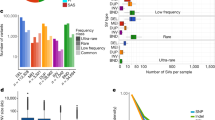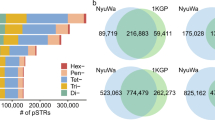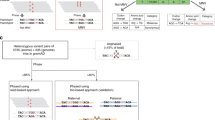Abstract
DNA sequence variations in individual genomes give rise to different phenotypes within the same species. One mechanism in this process is the alteration of chromatin structure due to sequence variation that influences gene regulation. We composed a high-confidence collection of human single-nucleotide polymorphisms and indels based on analysis of publicly available sequencing data and investigated whether the DNA loci associated with stable nucleosome positions are protected against mutations. We addressed how the sequence variation reflects the occupancy profiles of nucleosomes bearing different epigenetic modifications on genome scale. We found that indels are depleted around nucleosome positions of all considered types, whereas single-nucleotide polymorphisms are enriched around the positions of bulk nucleosomes but depleted around the positions of epigenetically modified nucleosomes. These findings indicate an increased level of conservation for the sequences associated with epigenetically modified nucleosomes, highlighting complex organization of the human chromatin.
This is a preview of subscription content, access via your institution
Access options
Subscribe to this journal
Receive 12 print issues and online access
$189.00 per year
only $15.75 per issue
Buy this article
- Purchase on Springer Link
- Instant access to full article PDF
Prices may be subject to local taxes which are calculated during checkout





Similar content being viewed by others
References
Jiang, C. & Pugh, B.F. Nucleosome positioning and gene regulation: advances through genomics. Nat. Rev. Genet. 10, 161–172 (2009).
Schones, D.E. & Zhao, K. Genome-wide approaches to studying chromatin modifications. Nat. Rev. Genet. 9, 179–191 (2008).
Segal, E. & Widom, J. From DNA sequence to transcriptional behaviour: a quantitative approach. Nat. Rev. Genet. 10, 443–456 (2009).
Kaplan, N. et al. The DNA-encoded nucleosome organization of a eukaryotic genome. Nature 458, 362–366 (2009).
Zhang, Y. et al. Intrinsic histone-DNA interactions are not the major determinant of nucleosome positions in vivo. Nat. Struct. Mol. Biol. 16, 847–852 (2009).
Valouev, A. et al. A high-resolution, nucleosome position map of C. elegans reveals a lack of universal sequence-dictated positioning. Genome Res. 18, 1051–1063 (2008).
Tolstorukov, M.Y., Kharchenko, P.V., Goldman, J.A., Kingston, R.E. & Park, P.J. Comparative analysis of H2A.Z nucleosome organization in the human and yeast genomes. Genome Res. 19, 967–977 (2009).
Boulikas, T. Evolutionary consequences of nonrandom damage and repair of chromatin domains. J. Mol. Evol. 35, 156–180 (1992).
Suter, B. & Thoma, F. DNA-repair by photolyase reveals dynamic properties of nucleosome positioning in vivo. J. Mol. Biol. 319, 395–406 (2002).
Washietl, S., Machne, R. & Goldman, N. Evolutionary footprints of nucleosome positions in yeast. Trends Genet. 24, 583–587 (2008).
Higasa, K. & Hayashi, K. Periodicity of SNP distribution around transcription start sites. BMC Genomics 7, 66 (2006).
Prendergast, J.G. et al. Chromatin structure and evolution in the human genome. BMC Evol. Biol. 7, 72 (2007).
Ying, H., Epps, J., Williams, R. & Huttley, G. Evidence that localized variation in primate sequence divergence arises from an influence of nucleosome placement on DNA repair. Mol. Biol. Evol. 27, 637–649 (2010).
Sasaki, S. et al. Chromatin-associated periodicity in genetic variation downstream of transcriptional start sites. Science 323, 401–404 (2009).
Barski, A. et al. High-resolution profiling of histone methylations in the human genome. Cell 129, 823–837 (2007).
Schones, D.E. et al. Dynamic regulation of nucleosome positioning in the human genome. Cell 132, 887–898 (2008).
Jin, C. et al. H3.3/H2A.Z double variant-containing nucleosomes mark 'nucleosome-free regions' of active promoters and other regulatory regions. Nat. Genet. 41, 941–945 (2009).
Kidd, J.M. et al. Mapping and sequencing of structural variation from eight human genomes. Nature 453, 56–64 (2008).
Lohr, D., Corden, J., Tatchell, K., Kovacic, R.T. & Van Holde, K.E. Comparative subunit structure of HeLa, yeast, and chicken erythrocyte chromatin. Proc. Natl. Acad. Sci. USA 74, 79–83 (1977).
Peckham, H.E. et al. Nucleosome positioning signals in genomic DNA. Genome Res. 17, 1170–1177 (2007).
Kharchenko, P.V., Woo, C.J., Tolstorukov, M.Y., Kingston, R.E. & Park, P.J. Nucleosome positioning in human HOX gene clusters. Genome Res. 18, 1554–1561 (2008).
Trifonov, E.N. & Sussman, J.L. The pitch of chromatin DNA is reflected in its nucleotide sequence. Proc. Natl. Acad. Sci. USA 77, 3816–3820 (1980).
Satchwell, S.C., Drew, H.R. & Travers, A.A. Sequence periodicities in chicken nucleosome core DNA. J. Mol. Biol. 191, 659–675 (1986).
Segal, E. et al. A genomic code for nucleosome positioning. Nature 442, 772–778 (2006).
Johnson, S.M., Tan, F.J., McCullough, H.L., Riordan, D.P. & Fire, A.Z. Flexibility and constraint in the nucleosome core landscape of Caenorhabditis elegans chromatin. Genome Res. 16, 1505–1516 (2006).
Mavrich, T.N. et al. Nucleosome organization in the Drosophila genome. Nature 453, 358–362 (2008).
Struhl, K. Naturally occurring poly(dA-dT) sequences are upstream promoter elements for constitutive transcription in yeast. Proc. Natl. Acad. Sci. USA 82, 8419–8423 (1985).
Segal, E. & Widom, J. Poly(dA:dT) tracts: major determinants of nucleosome organization. Curr. Opin. Struct. Biol. 19, 65–71 (2009).
Olson, W.K., Gorin, A.A., Lu, X.J., Hock, L.M. & Zhurkin, V.B. DNA sequence-dependent deformability deduced from protein-DNA crystal complexes. Proc. Natl. Acad. Sci. USA 95, 11163–11168 (1998).
Tanay, A. & Siggia, E.D. Sequence context affects the rate of short insertions and deletions in flies and primates. Genome Biol. 9, R37 (2008).
Schwartz, S., Meshorer, E. & Ast, G. Chromatin organization marks exon-intron structure. Nat. Struct. Mol. Biol. 16, 990–995 (2009).
Tilgner, H. et al. Nucleosome positioning as a determinant of exon recognition. Nat. Struct. Mol. Biol. 16, 996–1001 (2009).
Spies, N., Nielsen, C.B., Padgett, R.A. & Burge, C.B . Biased chromatin signatures around polyadenylation sites and exons. Mol. Cell 36, 245–254 (2009).
Wang, Z. & Burge, C.B. Splicing regulation: from a parts list of regulatory elements to an integrated splicing code. RNA 14, 802–813 (2008).
Bird, A.P. CpG-rich islands and the function of DNA methylation. Nature 321, 209–213 (1986).
Zhu, J., He, F., Hu, S. & Yu, J. On the nature of human housekeeping genes. Trends Genet. 24, 481–484 (2008).
Birney, E. et al. Identification and analysis of functional elements in 1% of the human genome by the ENCODE pilot project. Nature 447, 799–816 (2007).
Semple, C.A. & Taylor, M.S. Molecular biology. The structure of change. Science 323, 347–348 (2009).
Kogan, S. & Trifonov, E.N. Gene splice sites correlate with nucleosome positions. Gene 352, 57–62 (2005).
Warnecke, T., Batada, N.N. & Hurst, L.D. The impact of the nucleosome code on protein-coding sequence evolution in yeast. PLoS Genet. 4, e1000250 (2008).
Albert, I. et al. Translational and rotational settings of H2A.Z nucleosomes across the Saccharomyces cerevisiae genome. Nature 446, 572–576 (2007).
Lee, W. et al. A high-resolution atlas of nucleosome occupancy in yeast. Nat. Genet. 39, 1235–1244 (2007).
Kuhn, R.M. et al. The UCSC Genome Browser Database: update 2009. Nucleic Acids Res. 37, D755–D761 (2009).
Pruitt, K.D., Tatusova, T. & Maglott, D.R. NCBI reference sequences (RefSeq): a curated non-redundant sequence database of genomes, transcripts and proteins. Nucleic Acids Res. 35, D61–D65 (2007).
Wu, T.D. & Watanabe, C.K. GMAP: a genomic mapping and alignment program for mRNA and EST sequences. Bioinformatics 21, 1859–1875 (2005).
Akagi, K., Li, J., Stephens, R.M., Volfovsky, N. & Symer, D.E. Extensive variation between inbred mouse strains due to endogenous L1 retrotransposition. Genome Res. 18, 869–880 (2008).
Acknowledgements
We thank S. Sunyaev, I. Adzhubei and G. Kryukov for the helpful discussions. This project has been funded in part with federal funds from the US National Institutes of Health (GM082798 and U01HG004258 to P.J.P.; contract no. HHSN261200800001E to R.M.S.). The content of this publication does not necessarily reflect the views or policies of the Department of Health and Human Services, nor does mention of trade names, commercial products or organizations imply endorsement by the US government.
Author information
Authors and Affiliations
Contributions
M.Y.T. performed all analyses. N.V. and R.M.S. produced the collections of sequence variations. P.J.P. directed the project. M.Y.T. and P.J.P. wrote the manuscript.
Corresponding author
Ethics declarations
Competing interests
The authors declare no competing financial interests.
Supplementary information
Supplementary Text and Figures
Supplementary Figures 1–9, Supplementary Tables 1–4 and Supplementary Notes 1 and 2 (PDF 6952 kb)
Rights and permissions
About this article
Cite this article
Tolstorukov, M., Volfovsky, N., Stephens, R. et al. Impact of chromatin structure on sequence variability in the human genome. Nat Struct Mol Biol 18, 510–515 (2011). https://doi.org/10.1038/nsmb.2012
Received:
Accepted:
Published:
Issue Date:
DOI: https://doi.org/10.1038/nsmb.2012
This article is cited by
-
Epigenetics and genome stability
Mammalian Genome (2020)
-
Principles of nucleosome organization revealed by single-cell micrococcal nuclease sequencing
Nature (2018)
-
Nucleotide excision repair is impaired by binding of transcription factors to DNA
Nature (2016)
-
Associations between nucleosome phasing, sequence asymmetry, and tissue-specific expression in a set of inbred Medaka species
BMC Genomics (2015)
-
Epigenetics in the Human Brain
Neuropsychopharmacology (2013)



